Abstract
The efficacy of targeted therapeutics such as immunotoxins is directly related to both the extent of distribution achievable and the degree of drug internalization by individual cells in the tissue of interest. The factors that influence the tissue distribution of such drugs include drug transport; receptor/drug binding; and cellular pharmacology, the processing and routing of the drug within cells. To examine the importance of cellular pharmacology, previously treated only superficially, we have developed a mathematical model for drug transport in tissues that includes drug and receptor internalization, recycling, and degradation, as well as drug diffusion in the extracellular space and binding to cell surface receptors. We have applied this "cellular pharmacology model" to a model drug/cell system, specifically, transferrin and the well-defined transferrin cycle in CHO cells. We compare simulation results to models with extracellular diffusion only or diffusion with binding to cell surface receptors and present a parameter sensitivity analysis. The comparison of models illustrates that inclusion of intracellular trafficking significantly increases the total transferrin concentration throughout much of the tissue while decreasing the penetration depth. Increasing receptor affinity or tissue receptor density reduces permeation of extracellular drug while increasing the peak value of the intracellular drug concentration, resulting in "internal trapping" of transferrin near the source; this could account for heterogeneity of drug distributions observed in experimental systems. Other results indicate that the degree of drug internalization is not predicted by the total drug profile. Hence, when intracellular drug is required for a therapeutic effect, the optimal treatment may not result from conditions that produce the maximal total drug distribution. Examination of models that include cellular pharmacology may help guide rational drug design and provide useful information for whole body pharmacokinetic studies.
Full text
PDF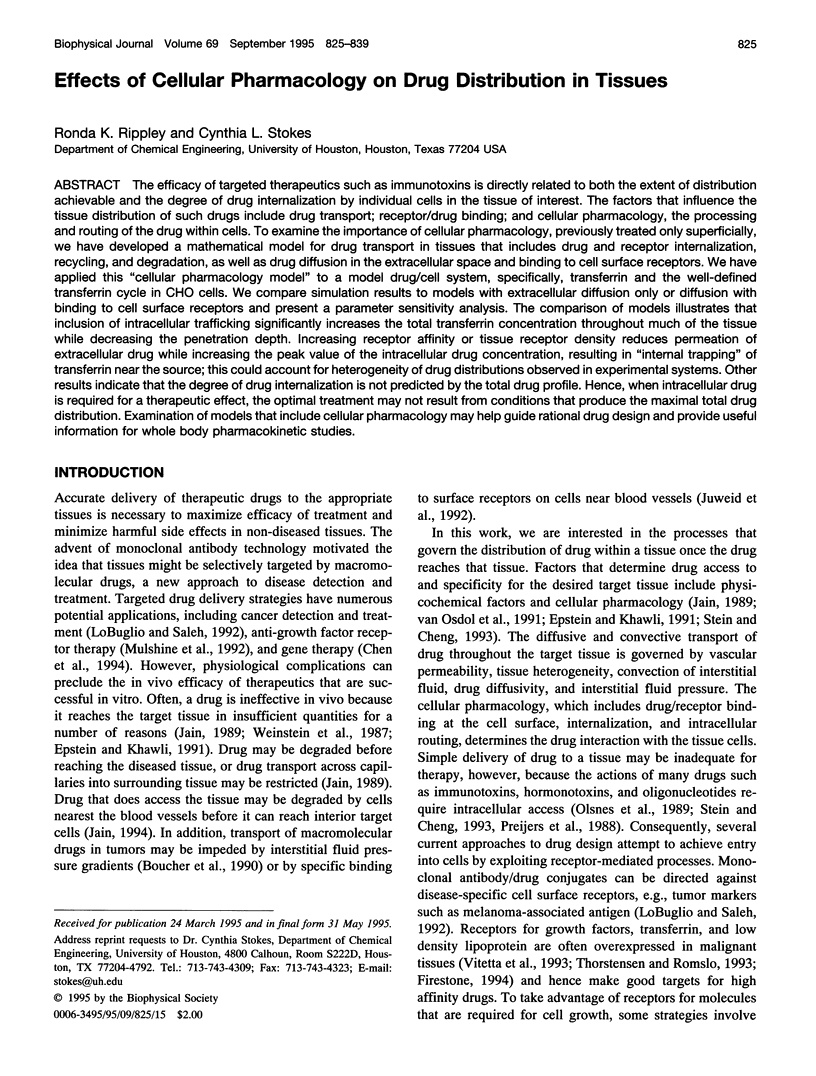



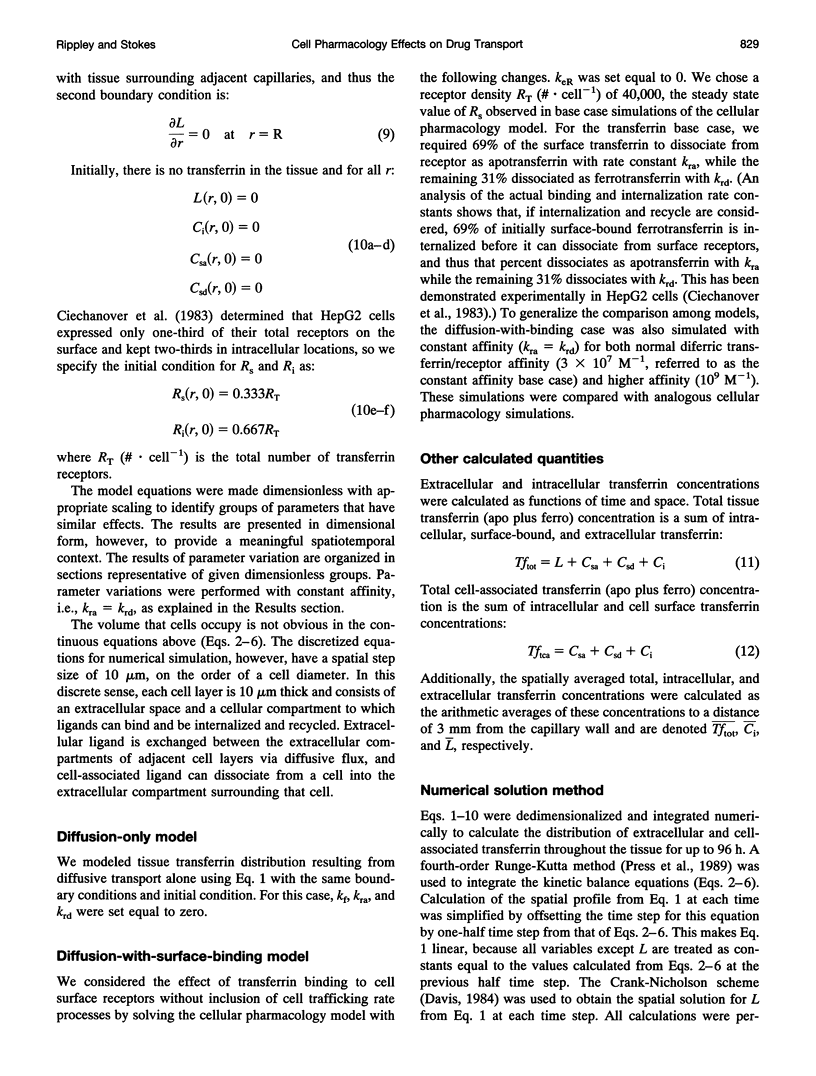
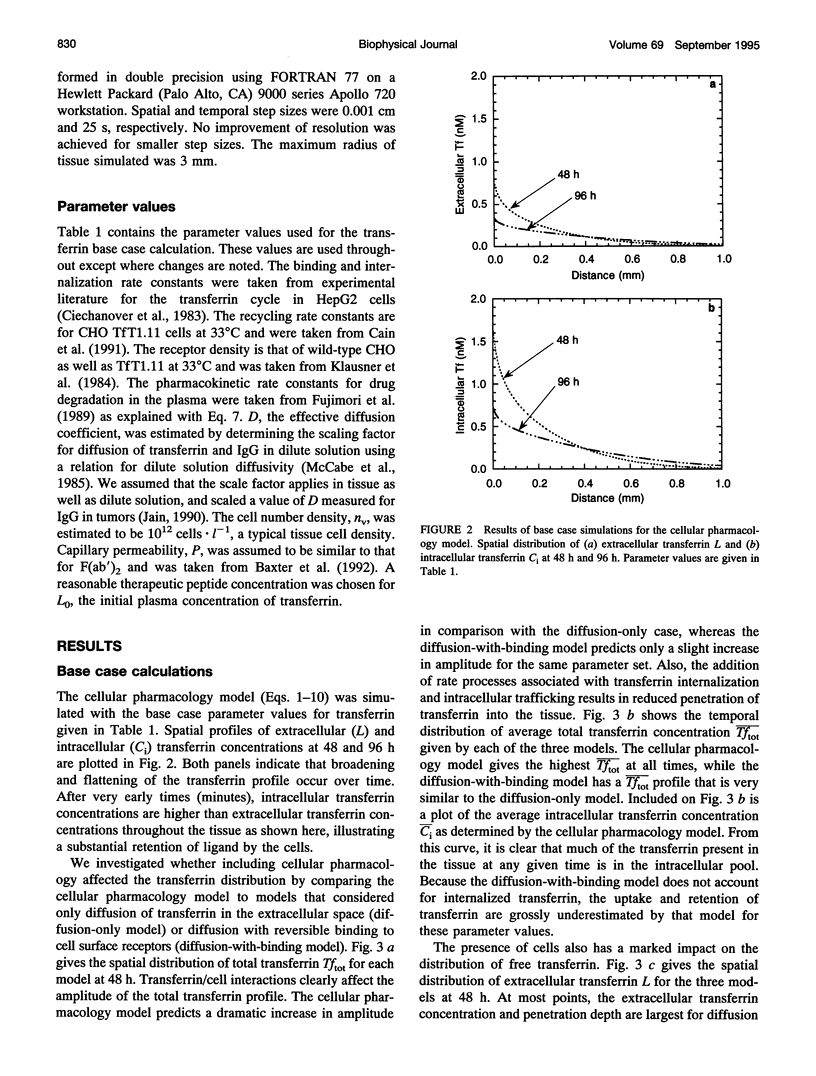

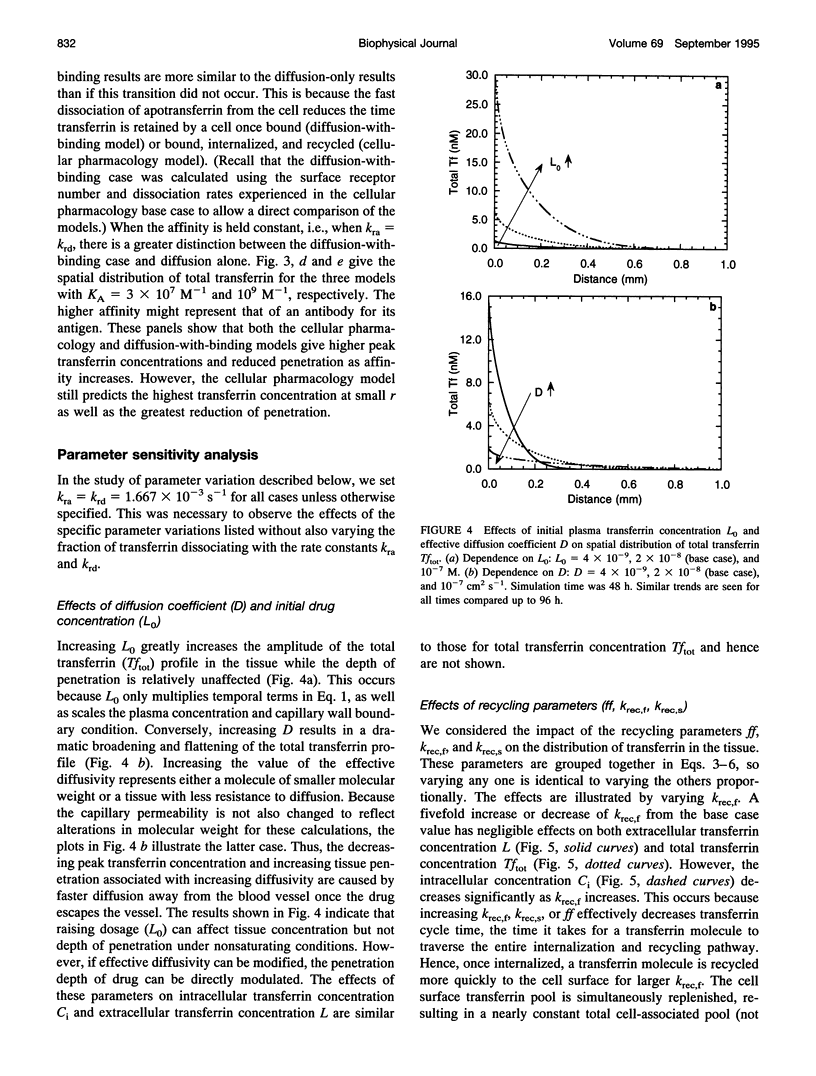
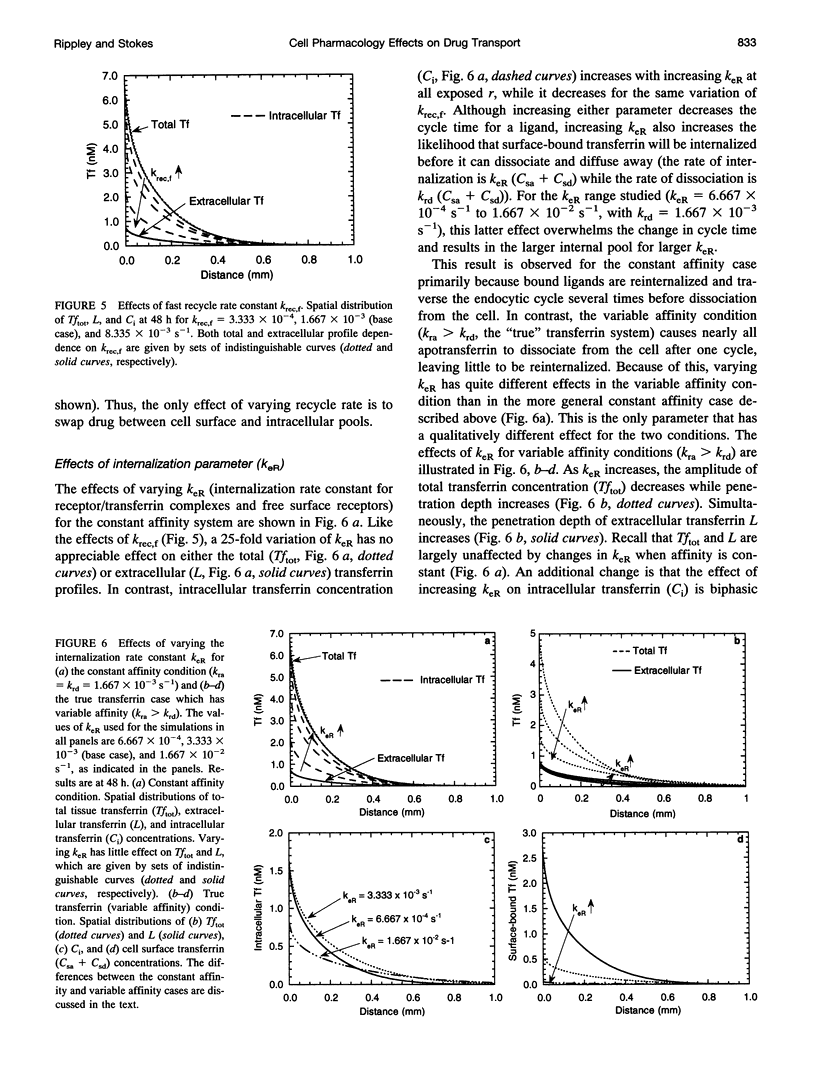

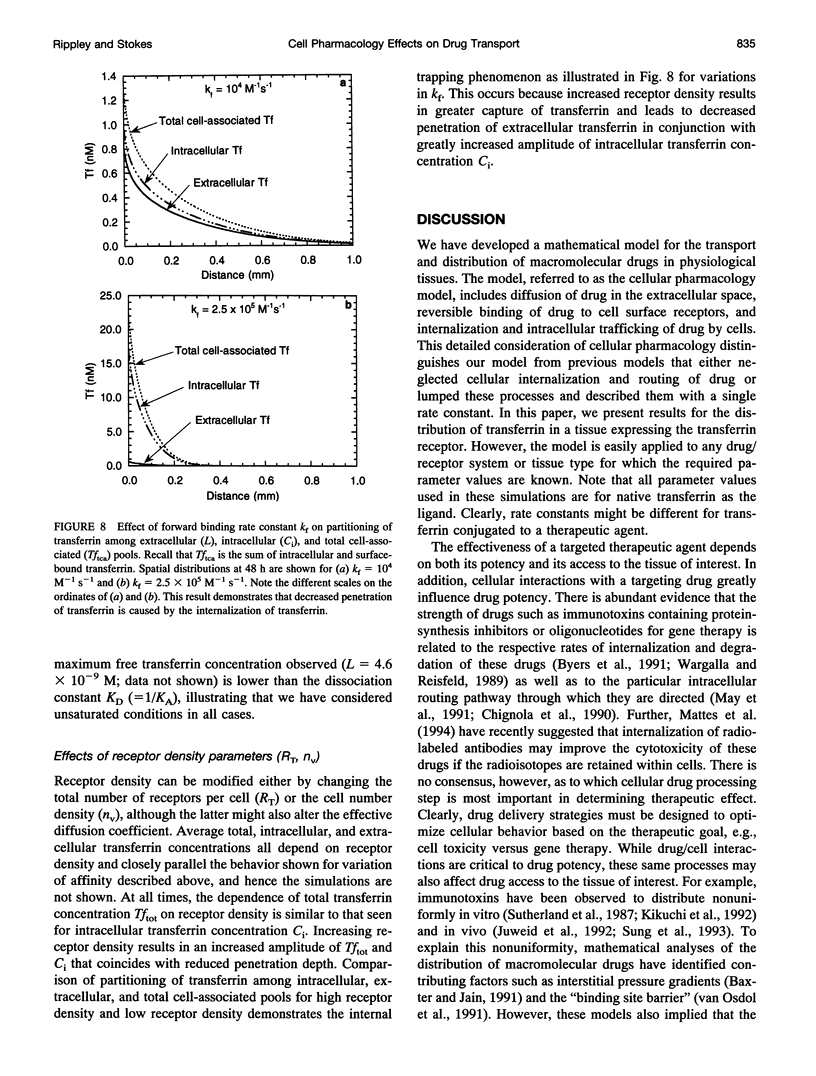
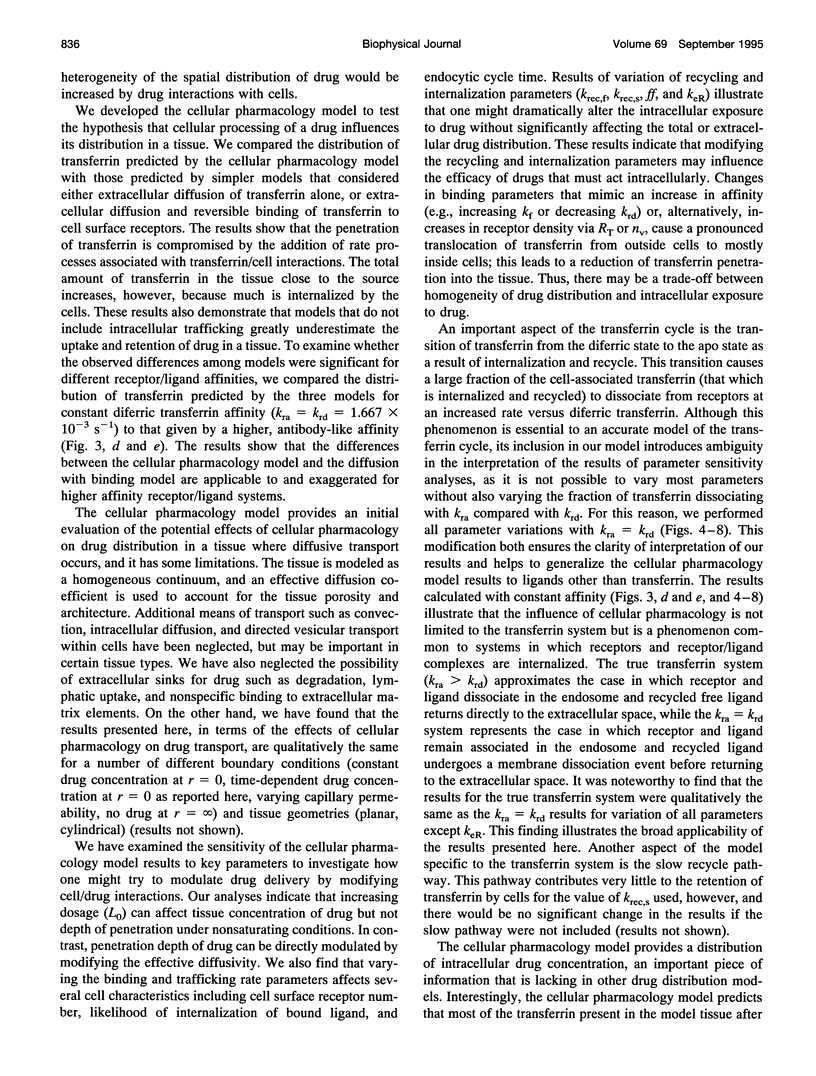
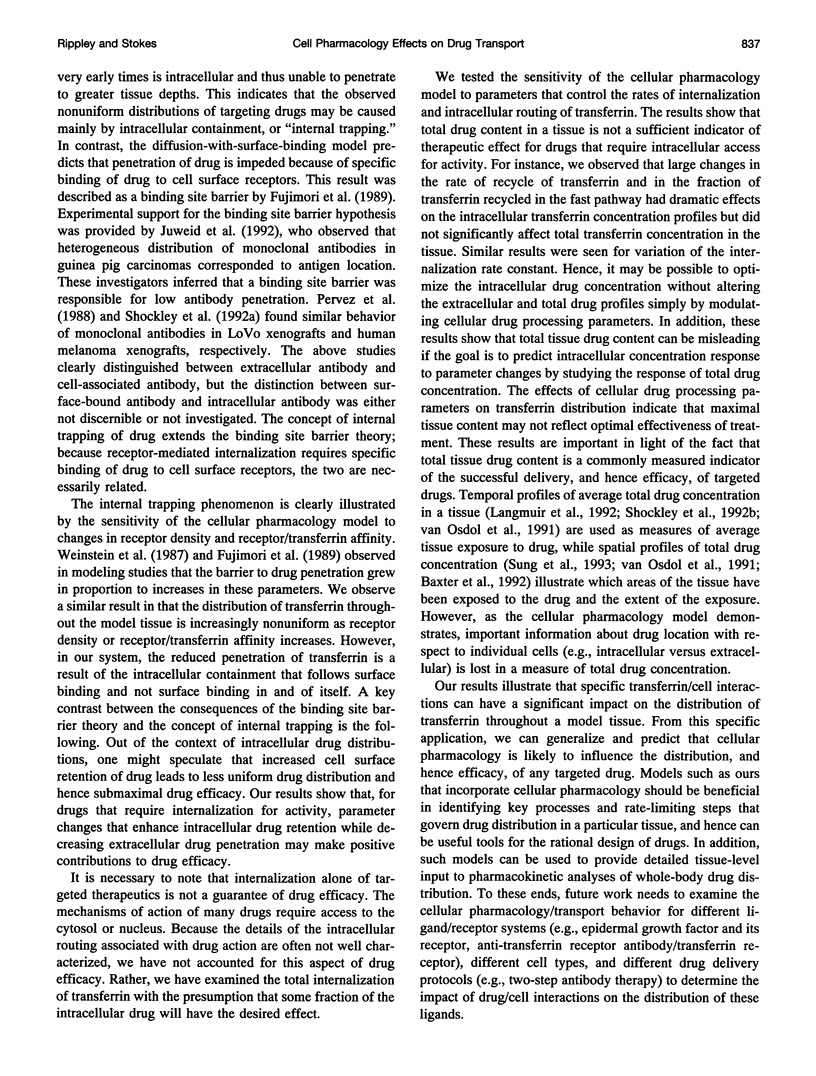

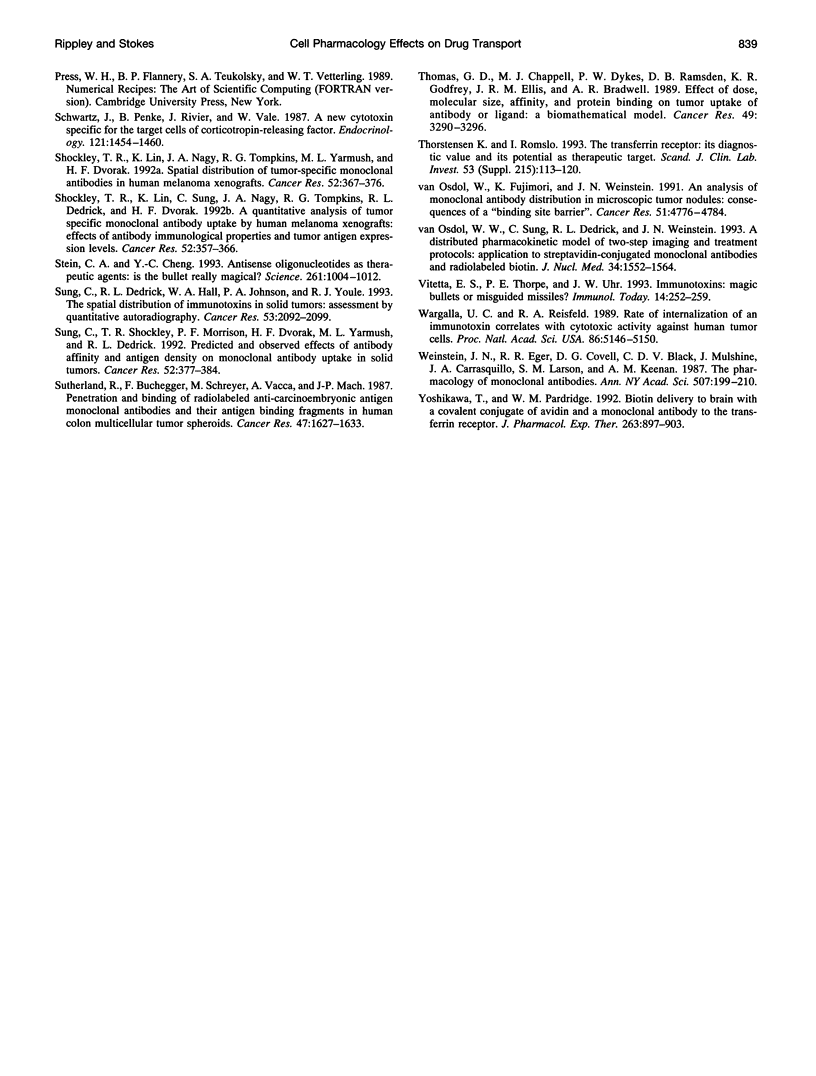
Selected References
These references are in PubMed. This may not be the complete list of references from this article.
- Akhtar S., Juliano R. L. Cellular uptake and intracellular fate of antisense oligonucleotides. Trends Cell Biol. 1992 May;2(5):139–144. doi: 10.1016/0962-8924(92)90100-2. [DOI] [PubMed] [Google Scholar]
- Baxter L. T., Jain R. K. Transport of fluid and macromolecules in tumors. III. Role of binding and metabolism. Microvasc Res. 1991 Jan;41(1):5–23. doi: 10.1016/0026-2862(91)90003-t. [DOI] [PubMed] [Google Scholar]
- Baxter L. T., Yuan F., Jain R. K. Pharmacokinetic analysis of the perivascular distribution of bifunctional antibodies and haptens: comparison with experimental data. Cancer Res. 1992 Oct 15;52(20):5838–5844. [PubMed] [Google Scholar]
- Boucher Y., Baxter L. T., Jain R. K. Interstitial pressure gradients in tissue-isolated and subcutaneous tumors: implications for therapy. Cancer Res. 1990 Aug 1;50(15):4478–4484. [PubMed] [Google Scholar]
- Byers V. S., Pawluczyk I. Z., Hooi D. S., Price M. R., Carroll S., Embleton M. J., Garnett M. C., Berry N., Robins R. A., Baldwin R. W. Endocytosis of immunotoxin-791T/36-RTA by tumor cells in relation to its cytotoxic action. Cancer Res. 1991 Apr 15;51(8):1990–1995. [PubMed] [Google Scholar]
- Cain C. C., Wilson R. B., Murphy R. F. Isolation by fluorescence-activated cell sorting of Chinese hamster ovary cell lines with pleiotropic, temperature-conditional defects in receptor recycling. J Biol Chem. 1991 Jun 25;266(18):11746–11752. [PubMed] [Google Scholar]
- Chen J., Gamou S., Takayanagi A., Shimizu N. A novel gene delivery system using EGF receptor-mediated endocytosis. FEBS Lett. 1994 Jan 31;338(2):167–169. doi: 10.1016/0014-5793(94)80357-9. [DOI] [PubMed] [Google Scholar]
- Chignola R., Colombatti M., Dell'Arciprete L., Candiani C., Tridente G. Distribution of endocytosed molecules to intracellular acidic environments correlates with immunotoxin activity. Int J Cancer. 1990 Dec 15;46(6):1117–1123. doi: 10.1002/ijc.2910460628. [DOI] [PubMed] [Google Scholar]
- Ciechanover A., Schwartz A. L., Dautry-Varsat A., Lodish H. F. Kinetics of internalization and recycling of transferrin and the transferrin receptor in a human hepatoma cell line. Effect of lysosomotropic agents. J Biol Chem. 1983 Aug 25;258(16):9681–9689. [PubMed] [Google Scholar]
- Citro G., Perrotti D., Cucco C., D'Agnano I., Sacchi A., Zupi G., Calabretta B. Inhibition of leukemia cell proliferation by receptor-mediated uptake of c-myb antisense oligodeoxynucleotides. Proc Natl Acad Sci U S A. 1992 Aug 1;89(15):7031–7035. doi: 10.1073/pnas.89.15.7031. [DOI] [PMC free article] [PubMed] [Google Scholar]
- Cotten M., Längle-Rouault F., Kirlappos H., Wagner E., Mechtler K., Zenke M., Beug H., Birnstiel M. L. Transferrin-polycation-mediated introduction of DNA into human leukemic cells: stimulation by agents that affect the survival of transfected DNA or modulate transferrin receptor levels. Proc Natl Acad Sci U S A. 1990 Jun;87(11):4033–4037. doi: 10.1073/pnas.87.11.4033. [DOI] [PMC free article] [PubMed] [Google Scholar]
- Dautry-Varsat A., Ciechanover A., Lodish H. F. pH and the recycling of transferrin during receptor-mediated endocytosis. Proc Natl Acad Sci U S A. 1983 Apr;80(8):2258–2262. doi: 10.1073/pnas.80.8.2258. [DOI] [PMC free article] [PubMed] [Google Scholar]
- Firestone R. A. Low-density lipoprotein as a vehicle for targeting antitumor compounds to cancer cells. Bioconjug Chem. 1994 Mar-Apr;5(2):105–113. doi: 10.1021/bc00026a002. [DOI] [PubMed] [Google Scholar]
- Fujimori K., Covell D. G., Fletcher J. E., Weinstein J. N. Modeling analysis of the global and microscopic distribution of immunoglobulin G, F(ab')2, and Fab in tumors. Cancer Res. 1989 Oct 15;49(20):5656–5663. [PubMed] [Google Scholar]
- Hirota N., Ueda M., Ozawa S., Abe O., Shimizu N. Suppression of an epidermal growth factor receptor-hyperproducing tumor by an immunotoxin conjugate of gelonin and a monoclonal anti-epidermal growth factor receptor antibody. Cancer Res. 1989 Dec 15;49(24 Pt 1):7106–7109. [PubMed] [Google Scholar]
- Jain R. K. Barriers to drug delivery in solid tumors. Sci Am. 1994 Jul;271(1):58–65. doi: 10.1038/scientificamerican0794-58. [DOI] [PubMed] [Google Scholar]
- Jain R. K. Delivery of novel therapeutic agents in tumors: physiological barriers and strategies. J Natl Cancer Inst. 1989 Apr 19;81(8):570–576. doi: 10.1093/jnci/81.8.570. [DOI] [PubMed] [Google Scholar]
- Juweid M., Neumann R., Paik C., Perez-Bacete M. J., Sato J., van Osdol W., Weinstein J. N. Micropharmacology of monoclonal antibodies in solid tumors: direct experimental evidence for a binding site barrier. Cancer Res. 1992 Oct 1;52(19):5144–5153. [PubMed] [Google Scholar]
- Karin M., Mintz B. Receptor-mediated endocytosis of transferrin in developmentally totipotent mouse teratocarcinoma stem cells. J Biol Chem. 1981 Apr 10;256(7):3245–3252. [PubMed] [Google Scholar]
- Kikuchi T., Ohnuma T., Holland J. F., Spitler L. E. Penetration of anti-melanoma immunotoxin into multicellular tumor spheroids and cell kill effects. Cancer Immunol Immunother. 1992;35(5):302–306. doi: 10.1007/BF01741142. [DOI] [PMC free article] [PubMed] [Google Scholar]
- Kim K. J., Li B., Winer J., Armanini M., Gillett N., Phillips H. S., Ferrara N. Inhibition of vascular endothelial growth factor-induced angiogenesis suppresses tumour growth in vivo. Nature. 1993 Apr 29;362(6423):841–844. doi: 10.1038/362841a0. [DOI] [PubMed] [Google Scholar]
- Klausner R. D., Ashwell G., van Renswoude J., Harford J. B., Bridges K. R. Binding of apotransferrin to K562 cells: explanation of the transferrin cycle. Proc Natl Acad Sci U S A. 1983 Apr;80(8):2263–2266. doi: 10.1073/pnas.80.8.2263. [DOI] [PMC free article] [PubMed] [Google Scholar]
- Klausner R. D., van Renswoude J., Kempf C., Rao K., Bateman J. L., Robbins A. R. Failure to release iron from transferrin in a Chinese hamster ovary cell mutant pleiotropically defective in endocytosis. J Cell Biol. 1984 Mar;98(3):1098–1101. doi: 10.1083/jcb.98.3.1098. [DOI] [PMC free article] [PubMed] [Google Scholar]
- Langmuir V. K., Mendonca H. L., Woo D. V. Comparisons between two monoclonal antibodies that bind to the same antigen but have differing affinities: uptake kinetics and 125I-antibody therapy efficacy in multicell spheroids. Cancer Res. 1992 Sep 1;52(17):4728–4734. [PubMed] [Google Scholar]
- Leichner P. K., Yang N. C., Wessels B. W., Hawkins W. G., Order S. E., Klein J. L. Dosimetry and treatment planning in radioimmunotherapy. Front Radiat Ther Oncol. 1990;24:109–122. [PubMed] [Google Scholar]
- LoBuglio A. F., Saleh M. N. Advances in monoclonal antibody therapy of cancer. Am J Med Sci. 1992 Sep;304(3):214–224. doi: 10.1097/00000441-199209000-00011. [DOI] [PubMed] [Google Scholar]
- Martell L. A., Agrawal A., Ross D. A., Muraszko K. M. Efficacy of transferrin receptor-targeted immunotoxins in brain tumor cell lines and pediatric brain tumors. Cancer Res. 1993 Mar 15;53(6):1348–1353. [PubMed] [Google Scholar]
- Mattes M. J., Griffiths G. L., Diril H., Goldenberg D. M., Ong G. L., Shih L. B. Processing of antibody-radioisotope conjugates after binding to the surface of tumor cells. Cancer. 1994 Feb 1;73(3 Suppl):787–793. doi: 10.1002/1097-0142(19940201)73:3+<787::aid-cncr2820731307>3.0.co;2-5. [DOI] [PubMed] [Google Scholar]
- May R. D., Wheeler H. T., Finkelman F. D., Uhr J. W., Vitetta E. S. Intracellular routing rather than cross-linking or rate of internalization determines the potency of immunotoxins directed against different epitopes of sIgD on murine B cells. Cell Immunol. 1991 Jul;135(2):490–500. doi: 10.1016/0008-8749(91)90292-j. [DOI] [PubMed] [Google Scholar]
- McFadden R., Kwok C. S. Mathematical model of simultaneous diffusion and binding of antitumor antibodies in multicellular human tumor spheroids. Cancer Res. 1988 Jul 15;48(14):4032–4037. [PubMed] [Google Scholar]
- Olsnes S., Sandvig K., Petersen O. W., van Deurs B. Immunotoxins--entry into cells and mechanisms of action. Immunol Today. 1989 Sep;10(9):291–295. [PubMed] [Google Scholar]
- Pervez S., Epenetos A. A., Mooi W. J., Evans D. J., Rowlinson G., Dhokia B., Krausz T. Localization of monoclonal antibody AUA1 and its F(ab')2 fragments in human tumour xenografts: an autoradiographic and immunohistochemical study. Int J Cancer Suppl. 1988;3:23–29. doi: 10.1002/ijc.2910410806. [DOI] [PubMed] [Google Scholar]
- Pirker R., FitzGerald D. J., Hamilton T. C., Ozols R. F., Willingham M. C., Pastan I. Anti-transferrin receptor antibody linked to Pseudomonas exotoxin as a model immunotoxin in human ovarian carcinoma cell lines. Cancer Res. 1985 Feb;45(2):751–757. [PubMed] [Google Scholar]
- Preijers F. W., Tax W. J., De Witte T., Janssen A., vd Heijden H., Vidal H., Wessels J. M., Capel P. J. Relationship between internalization and cytotoxicity of ricin A-chain immunotoxins. Br J Haematol. 1988 Nov;70(3):289–294. doi: 10.1111/j.1365-2141.1988.tb02484.x. [DOI] [PubMed] [Google Scholar]
- Schwartz J., Penke B., Rivier J., Vale W. A new cytotoxin specific for the target cells of corticotropin-releasing factor. Endocrinology. 1987 Oct;121(4):1454–1460. doi: 10.1210/endo-121-4-1454. [DOI] [PubMed] [Google Scholar]
- Shockley T. R., Lin K., Nagy J. A., Tompkins R. G., Yarmush M. L., Dvorak H. F. Spatial distribution of tumor-specific monoclonal antibodies in human melanoma xenografts. Cancer Res. 1992 Jan 15;52(2):367–376. [PubMed] [Google Scholar]
- Shockley T. R., Lin K., Sung C., Nagy J. A., Tompkins R. G., Dedrick R. L., Dvorak H. F., Yarmush M. L. A quantitative analysis of tumor specific monoclonal antibody uptake by human melanoma xenografts: effects of antibody immunological properties and tumor antigen expression levels. Cancer Res. 1992 Jan 15;52(2):357–366. [PubMed] [Google Scholar]
- Stein C. A., Cheng Y. C. Antisense oligonucleotides as therapeutic agents--is the bullet really magical? Science. 1993 Aug 20;261(5124):1004–1012. doi: 10.1126/science.8351515. [DOI] [PubMed] [Google Scholar]
- Sung C., Dedrick R. L., Hall W. A., Johnson P. A., Youle R. J. The spatial distribution of immunotoxins in solid tumors: assessment by quantitative autoradiography. Cancer Res. 1993 May 1;53(9):2092–2099. [PubMed] [Google Scholar]
- Sung C., Shockley T. R., Morrison P. F., Dvorak H. F., Yarmush M. L., Dedrick R. L. Predicted and observed effects of antibody affinity and antigen density on monoclonal antibody uptake in solid tumors. Cancer Res. 1992 Jan 15;52(2):377–384. [PubMed] [Google Scholar]
- Sutherland R., Buchegger F., Schreyer M., Vacca A., Mach J. P. Penetration and binding of radiolabeled anti-carcinoembryonic antigen monoclonal antibodies and their antigen binding fragments in human colon multicellular tumor spheroids. Cancer Res. 1987 Mar 15;47(6):1627–1633. [PubMed] [Google Scholar]
- Thomas G. D., Chappell M. J., Dykes P. W., Ramsden D. B., Godfrey K. R., Ellis J. R., Bradwell A. R. Effect of dose, molecular size, affinity, and protein binding on tumor uptake of antibody or ligand: a biomathematical model. Cancer Res. 1989 Jun 15;49(12):3290–3296. [PubMed] [Google Scholar]
- Thorstensen K., Romslo I. The transferrin receptor: its diagnostic value and its potential as therapeutic target. Scand J Clin Lab Invest Suppl. 1993;215:113–120. doi: 10.3109/00365519309090703. [DOI] [PubMed] [Google Scholar]
- Vitetta E. S., Thorpe P. E., Uhr J. W. Immunotoxins: magic bullets or misguided missiles? Immunol Today. 1993 Jun;14(6):252–259. doi: 10.1016/0167-5699(93)90041-I. [DOI] [PubMed] [Google Scholar]
- Wargalla U. C., Reisfeld R. A. Rate of internalization of an immunotoxin correlates with cytotoxic activity against human tumor cells. Proc Natl Acad Sci U S A. 1989 Jul;86(13):5146–5150. doi: 10.1073/pnas.86.13.5146. [DOI] [PMC free article] [PubMed] [Google Scholar]
- Weinstein J. N., Eger R. R., Covell D. G., Black C. D., Mulshine J., Carrasquillo J. A., Larson S. M., Keenan A. M. The pharmacology of monoclonal antibodies. Ann N Y Acad Sci. 1987;507:199–210. doi: 10.1111/j.1749-6632.1987.tb45802.x. [DOI] [PubMed] [Google Scholar]
- Yoshikawa T., Pardridge W. M. Biotin delivery to brain with a covalent conjugate of avidin and a monoclonal antibody to the transferrin receptor. J Pharmacol Exp Ther. 1992 Nov;263(2):897–903. [PubMed] [Google Scholar]
- van Osdol W. W., Sung C., Dedrick R. L., Weinstein J. N. A distributed pharmacokinetic model of two-step imaging and treatment protocols: application to streptavidin-conjugated monoclonal antibodies and radiolabeled biotin. J Nucl Med. 1993 Sep;34(9):1552–1564. [PubMed] [Google Scholar]
- van Osdol W., Fujimori K., Weinstein J. N. An analysis of monoclonal antibody distribution in microscopic tumor nodules: consequences of a "binding site barrier". Cancer Res. 1991 Sep 15;51(18):4776–4784. [PubMed] [Google Scholar]


